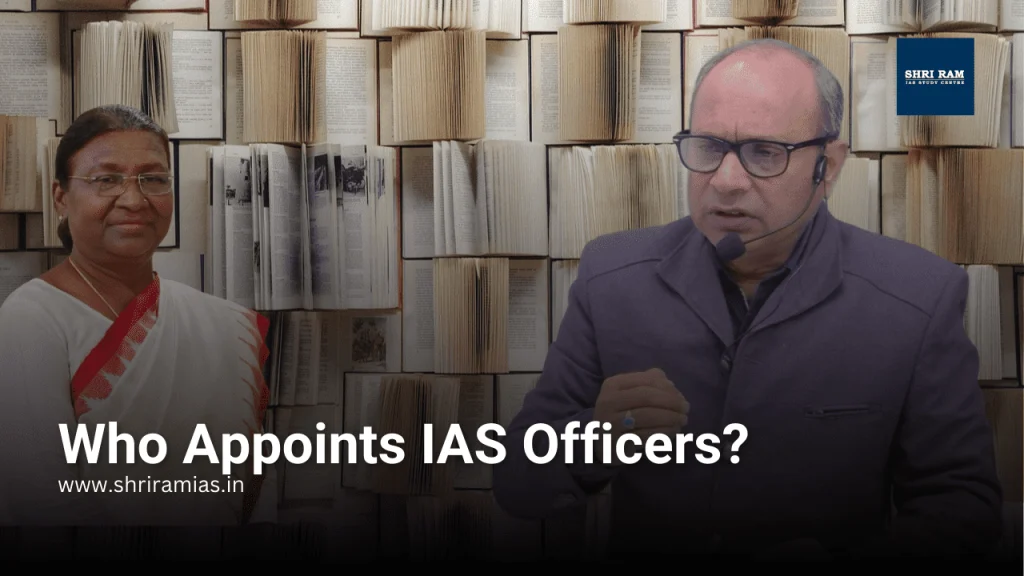The Indian Administrative Service (IAS) is one of the most prestigious services in India. Every year, thousands of aspirants compete to join this elite service. But have you ever wondered who appoints IAS officers and how the process works?
Who Has the Authority to Appoint IAS Officers?
The President of India appoints IAS officers based on UPSC’s recommendation. UPSC conducts the Civil Services Examination to select eligible candidates. After clearing the exam, candidates move to the next step of appointment.
The appointment process follows Article 312 of the Indian Constitution. This article allows the creation of All India Services, including IAS. The selection ensures that only the most deserving candidates join the administration.
Once selected, candidates receive appointment orders from the DoPT. This department handles the posting and cadre allocation of IAS officers. The final step places them in different states or central roles.
Role of UPSC in IAS Appointment
UPSC conducts the Civil Services Examination (CSE) every year to select IAS officers. The exam has three stages: Prelims, Mains, and Interview. Candidates must clear all stages to qualify for the final selection.
After the final selection, UPSC prepares a list of successful candidates. This list is then sent to the President of India for approval. The President officially appoints the selected candidates as IAS officers.
Based on UPSC’s recommendation, the government issues appointment letters. The Department of Personnel and Training (DoPT) then assigns cadres. This marks the beginning of their journey as IAS officers.
Role of DoPT in IAS Appointments
The Department of Personnel and Training (DoPT) manages the appointment of IAS officers. It ensures that officers are assigned to different cadres based on available vacancies. The allocation follows specific cadre policies set by the government.
DoPT plays a key role in the career of IAS officers. It not only assigns cadres but also oversees their training and initial postings. The Lal Bahadur Shastri National Academy of Administration (LBSNAA) conducts this training.
Apart from appointments, DoPT handles promotions and service conditions. It ensures officers receive proper career growth opportunities. Throughout their careers, IAS officers remain under DoPT’s supervision.
How are IAS Officers Assigned to Cadres?
Once appointed, IAS officers are assigned to different state cadres. The cadre allocation policy ensures a fair distribution of officers across states. The government follows a roster system to maintain balance in officer postings.
IAS officers primarily serve under the state government. They handle key administrative roles in districts and departments. However, they can be deputed to the central government for specific assignments.
During central deputation, officers work in ministries and national organizations. Their expertise is used for policymaking and national projects. This system allows officers to gain diverse administrative experience.
Can the President Remove an IAS Officer?
Yes, the President has the power to remove an IAS officer, but only under strict conditions. An officer can be dismissed for misconduct, corruption, or inefficiency. However, the removal process follows strict legal procedures and requires approval from the DoPT and UPSC.
Who Controls IAS Officers After Appointment?
IAS officers work under both state and central governments. While they serve in state administrations, the central government has control over their transfers, promotions, and disciplinary actions. The Chief Minister and Chief Secretary oversee IAS officers at the state level, while the Prime Minister’s Office (PMO) and Cabinet Secretariat handle central postings.
Training of IAS Officers After Appointment
After appointment, IAS officers undergo training at the Lal Bahadur Shastri National Academy of Administration (LBSNAA) in Mussoorie. The training includes administrative law, policy-making, leadership skills, and governance. Officers also get field exposure through Bharat Darshan (national tour) and district postings.
Start preparing UPSC Civil Services Examination.
Promotion and Career Growth of IAS Officers
IAS officers start their careers as Sub-Divisional Magistrates (SDMs) and gradually move up the ranks. With experience, they get promoted to District Magistrate (DM), Commissioner, Secretary, and Chief Secretary. Some officers also serve in key roles like Cabinet Secretary and Principal Secretary to the Prime Minister.
Conclusion: A Prestigious Role with National Importance
The President of India appoints IAS officers based on UPSC recommendations. After selection, officers play a crucial role in shaping India’s administration. The government ensures a transparent appointment process to maintain efficiency and integrity in public service.
Why Choose SHRI RAM IAS for IAS Preparation?
If you dream of becoming an IAS officer, SHRI RAM IAS is the best place to prepare. It is known as the best IAS coaching in Delhi with low fees, offering expert faculty, structured courses, and personal mentorship. The institute provides affordable IAS coaching in Delhi with both online and offline classes. Enroll now and start your journey towards success!

